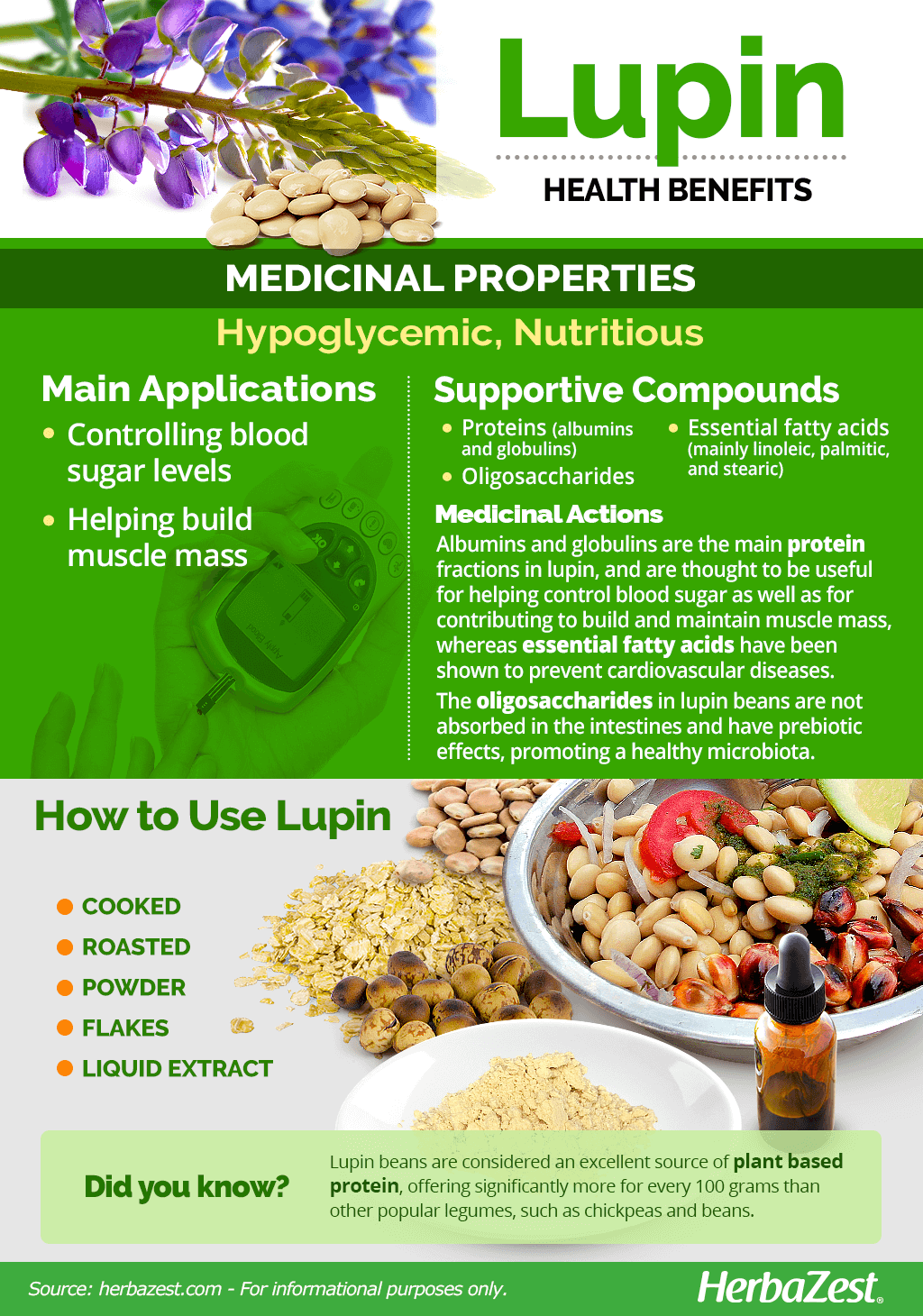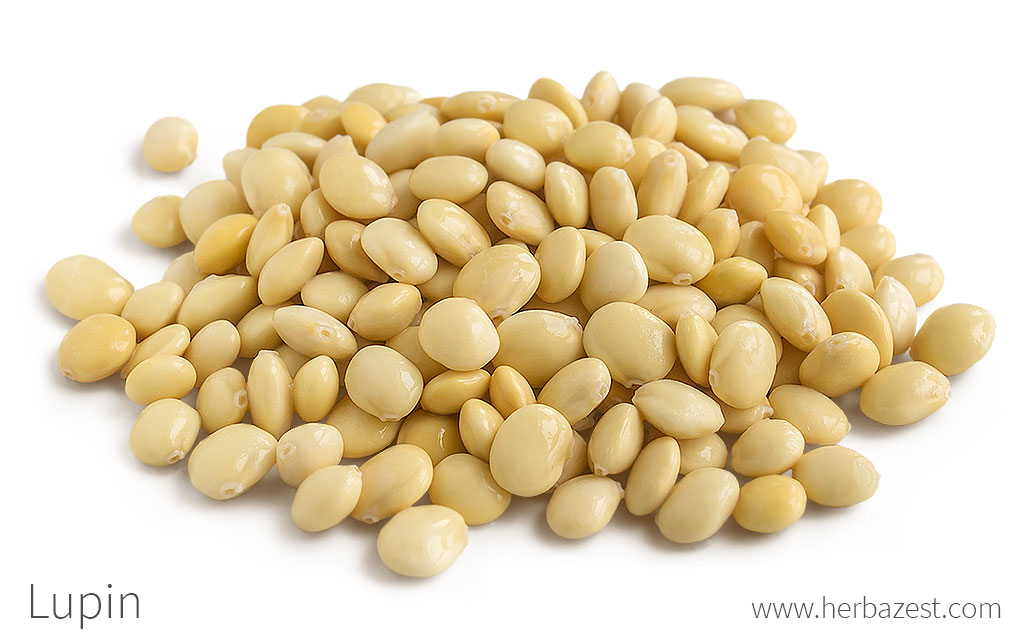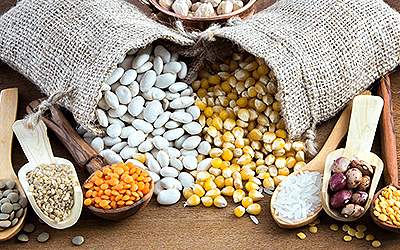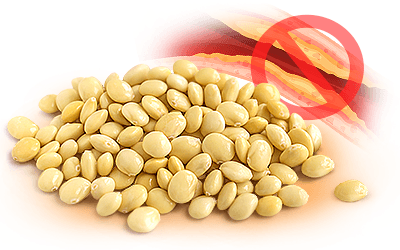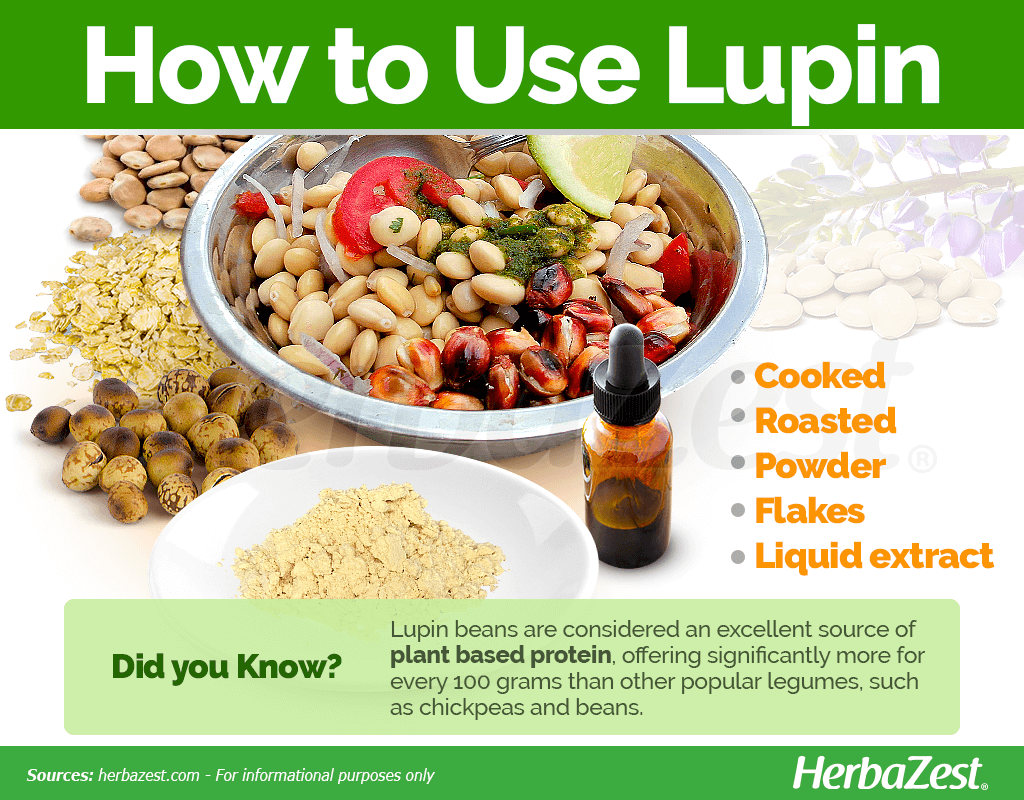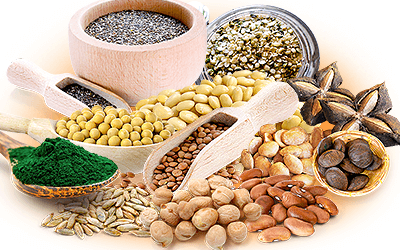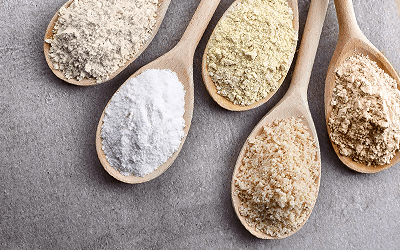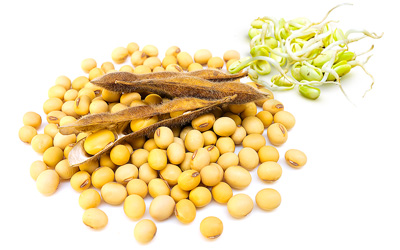The lupine or lupin beans come in different varieties and are cultivated across the globe. Among the most popular lupin beans is pearl lupin, also known as Andean lupin. This type of lupin is rich in nutrients and medicinal properties and has been consumed for centuries in South America, Central America, and parts of North America.
Lupin Medicinal Properties
- Medicinal action Hypoglycemic, Nutritious
- Key constituents Proteins, essential fatty acids, oligosaccharides
- Ways to use Liquid extracts, Food, Powder
- Medicinal rating (4) Very useful plant
- Safety ranking Use with caution
Health Benefits of Lupin
Lupin beans are full of beneficial compounds, going way beyond their nutritional content. Some of the most widely studied lupin health benefits are:
Controlling blood sugar levels. A variety of scientific studies have found that adding lupin to foods can improve glycemic control.1
Helping build muscle mass. Lupin is an impressive source of essential amino acids, which are the building blocks of protein used by the body for muscle growth and strength. Interestingly, lupin can help reduce muscle loss caused by orthotic devices.2
Lupin is also highly satiating, which helps reduce food cravings and maintain a healthy body weight. Additionally, lupin helps lower blood pressure, thus offering cardiovascular benefits.3 It also improves gut health by promoting a balanced gastrointestinal macrobiota.
How It Works
Like other legumes, lupin beans offer a wide arrange of nutrients, like proteins, essential fatty acids, and oligosaccharides, among other antioxidant compounds.
The high amount of proteins in most commercialized lupin varieties seems to be partly responsible for the hypoglycemic effects of these legumes. The most important protein fractions in most lupin species are albumins and globulins. One particular component of globulin, y-conglutin, has been shown to enhance the effects of insulin and metformin on cellular glucose metabolism, which means it can be useful for controlling blood sugar.4
Other important compounds in various lupin varieties are essential fatty acids, such as linoleic, palmitic, and stearic acids, which have been shown helpful for preventing cardiovascular diseases.5
Also, several human trials have shown that lupin lowers cholesterol levels, further decreasing heart disease risk.6
Lupin beans are also rich in oligosaccharides, a particular type of carbohydrates that is not absorbed in the intestines and exhibits prebiotic properties. The fermentation of these oligosaccharides promotes a healthy microbiota.
Lupin Side Effects
The presence of mildly toxic alkaloids in some lupin varieties (mainly spartaine) can trigger anticholergenic effects, inhibiting nerve impulses, which can cause sudden nausea and vomiting as well as blurred vision, weakness, and tachycardia. These effects have being reported in people taking lupin in therapeutic doses and are unlikely to occur when lupin beans are consumed in moderation in culinary forms.
DUE TO THEIR HIGH RISK OF POTENTIAL TOXICITY, BITTER VARIETIES OF LUPIN ARE NOT RECOMMENDED FOR HUMAN OR ANIMAL CONSUMPTION.
People with IBS or IBD should be aware that lupin beans are rich in a particular group of sugars called oligosaccharides, which are usually beneficial for human gut flora but may cause abdominal discomfort in those sensitive to FODMAPs.
Being legumes related to peanuts, lupin beans can also trigger allergic reactions in sensitive people, which may include hives, itching, swelling, abdominal pain,nausea, vomiting, runny nose, watery eyes, and more. Severe reactions may include difficulty breathing, cough, wheezing, and low blood pressure.
Lupin Nutrition
Lupin seeds are full of nutrients and are considered an excellent source of complete protein, offering significantly higher amounts per every 100 grams than other popular legumes, such as chickpeas and beans.
Protein is essential not only for building and maintaining a healthy muscle mass, but also for the structural integrity and proper functioning of cells, tissues, enzymes, and hormones. Since the human body is not able to store protein, it must be supplied through a balanced diet.
Lupin beans are also abundant in dietary fiber, which promotes regular bowel movements and favors a healthy gastrointestinal flora.
This remarkable and underrated legume is also rich in a wide arrange of minerals, mainly copper, which plays an important role in the production and transport of red cells; and manganese, which has a crucial antioxidant function within the cells and plays a role in the metabolism of carbohydrates, amino acids, and cholesterol.
Other minerals that are present in generous amounts in lupin beans are iron, zinc, phosphorus, and magnesium; along with good levels of selenium and potassium, and adequate proportions of calcium.
As it is usual in legumes, lupin provides most B vitamins, with particularly outstanding amounts of B9 (folate), along with good levels of B1 (thiamin) and B6 (pyridoxine). It also offers a fair quantity of choline, considered essential for a number of vital functions, such as normal metabolism, transport of lipids, methylation reactions (which include nervous, cardiovascular and immune system activities), and the synthesis of neurotransmitters.
Other vitamins present in small amounts in lupin beans are vitamins E (alpha tocopherol) and K (phylloquinone).
100 GRAMS OF COOKED LUPIN BEANS PROVIDE 269 CALORIES, WHICH ARE MAINLY COMPOSED OF PROTEIN (29% DV), DIETARY FIBER (50% DV), AND OTHER CARBOHYDRATES (15% DV).
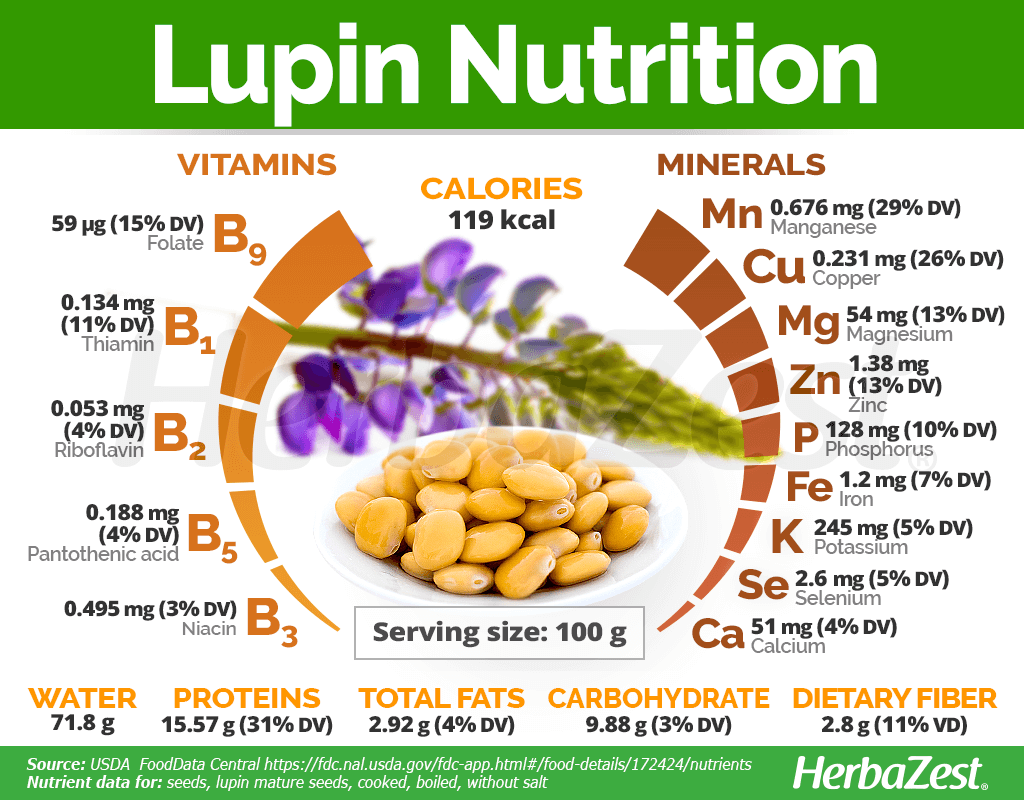
How to Consume Lupin
- Edible parts Seed
- Edible uses Protein
- Taste Mild
Natural forms
Cooked. Boiled as any other legume, lupin beans provide plenty of energy and nutrition. Once cooked, lupin can be made into hummus and consumed in wraps or with crackers or fresh vegetables.
Roasted. The dried and roasted lupin beans make for a nutritious snack, full of protein and dietary fiber. They are promoted as an alternative to edamame; however, care should be taken with high amounts of sodium in commercial brands.
Powder. This is the most popular way of consuming lupin beans. In this form, lupin can be added to baked goods and smoothies for an extra punch of protein in a balanced diet or after workouts.
Flakes. Lupin seeds can be processed into flakes and consumed as regular cereal with the added benefit of high levels of protein and fiber.
Herbal Remedies & Supplements
Liquid extract. Lupin seed extract is a highly concentrated preparation with great levels of protein and beneficial oils. It is often touted as a stimulant of collagen production and used as emollient agent for strengthening hair as well as for promoting skin elasticity.
Growing
- Life cycle Perennial
- Harvested parts Seeds
- Light requirements Full sun, Partial shade
- Soil Light (sandy), Well-drained
- Soil pH 4.5 – 5.0 (Very strongly acidic), 5.1 – 5.5 (Strongly acidic), 5.6 – 6.0 (Moderately acidic), 6.1 – 6.5 (Slightly acidic), 6.6 – 7.3 (Neutral)
- Growing habitat Temperate climates, Warm climates
- Pre-germination seed treatment None, Soaking
- Planting time Early spring
- Plant spacing average 0.5 m (1.64 ft)
- Growing time 3 weeks
- Potential insect pests Aphids, Bugs
- Potential diseases Mildew, Rust
Because of their pretty flowers, lupin plants can be grown as border ornamentals, and they are naturally found in meadows and moist areas. Lupin beans are fairly easy to cultivate, given the right conditions of soil, wheater, and humidity.
Growing Guidelines
- Did you know?
Like other legumes, lupins are able to fix their own nitrogen. However, a rhizobium inoculation is required in young plants, as they develop strong nodules. Rhizobium inoculations are recommended every 5 years.
Lupin plants prefer moist and acidic environments; although most species occur in poor soils, rocky and dry, they prefer a sandy soil, with a pH range of 4.5-7.
Lupin plants will not tolerate high heat and humidity. They can grow well with both sun to part shade.
Lupin seeds can be sown at the beginning of the warm season, either dry or after being soaked in water overnight. Sowing into wet soil ensures rapid growing (about 15 mm over two days).
When sown in rows of 20 inches (50 cm) and greater, one to two inches (3-5 cm) below the soil surface, lupin plants provide better yields.
Tall cultivars of lupin may need some sort of support while growing.
Lupin beans are better harvested when ripe, at about three weeks of maturity. At that time, the pods get a pale yellow color, and the beans rattle when shaken.
Lupin plants can be susceptible to brown spot, powdery mildew, rust, aphids, and four-lined plant bug infestations.
Additional Information
- Other uses Cosmetics
Plant Biology
Lupin, or lupine, is a short-lived perennial. This legume grows up to 3-4 inches (7.5-10 cm) tall and 1-2 inches (2.5-5 cm) wide. It develops dense raceme of 1-2 inches (2.5.5 cm) log at its tops, with unassuming individual flowers whose color range from yellow, red, pink and purple, to white and variegated.
Classification
Lupin (Lupinus spp.) belong to the large Fabaceae or legume family, home of 700 genera and about 17,000 species, including economically important crops such as alfalfa (Medicago sativa), bean (Phaseolus vulgaris), carob (Ceratonia siliqua), fenugreek (Trigonella foenum-graecum), licorice (Glycyrrhiza glabra), pea (Pisum sativum), chickpea (Cicer arietinum), lentil (Lens culinaris), peanut (Arachis hypogaea), soy (Glycine max), tamarind (Tamarindus indica), and winged bean (Psophocarpus tetragonolobus).
Lupin Varieties
There are several species in the genus Lupinus; however, the most economically important ones include Lupinus albus (European lupin); Lupinus luteus (yellow lupin), mainly grown in Germany and Eastern Europe; and Lupinus angustifolius (narrow leafed lupin), the main lupin grown in Australia, especially in Western Australia.7 On the other hand, Lupinus mutabilis, known as Andean lupin or tarwi, originated in the Peruvian Andes, but it is closely related to a lupin species native to Southern Europe.8
A particular Lupinus species, Lupinus polyphyllus (known as garden lupin) is used exclusively for ornamental purposes and considered as an invasive herb in North America, Europe, Australia and New Zealand.
Historical Information
The first written records of human lupin consumption date back to the ancient Egyptian, Greek, Roman, and Pre-Incan civilizations. Lupin plants were popular as a cover crop during the 17th and 18th centuries, and their ability to fix nitrogen was commonly used for soil-improvement.
Lupin meal, used for making bread and other culinary purposes, was widely popular during the 19th century across Spain and Italy. More recently, in the 20th century, several species of lupin were cultivated in the southern United States, particularly in areas with poor soils.
LUPIN MEAL AND FLOUR WERE MADE FROM COOKED, DRIED, AND GROUND BEANS IN ORDER TO ELIMINATE ANY TRACE OF TOXIC ALKALOIDS.
It wasn't until the early 20th century that German scientists subjected lupin to a process of hybridization in order to transform it into a modern commercial crop. The successful development of "sweet lupin" varieties, with lower levels of bitter alkaloids, sparked the popularity of these legumes across Europe, quickly spreading to Australia, where more sweet lupins are produced nowadays than anywhere else in the world.9
Economic Data
Since 1999, Australia has been the leading producer of lupin, followed by some Eastern European countries, such as Russia, Poland, and Germany. Over 2 million tonnes of lupin beans are harvested annually across the world.
The most cultivated lupin species in Australia is L. angustifolius (narrow-leafed lupin) and more than 80% is grown in Western Australia.
On the other hand, bitter L. mutabilis is still cultivated in small quantities, using traditional methods in Ecuador, Peru and Bolivia, whereas limited cultivation of L. albus have been happening in the USA and Canada.10
Other Uses of Lupin
Fodder. The same Lupinus species edible to humans are used to feed cattle and other farm animals.
Gardening. Appreciated for their pretty flowers and small size, some lupin varieties, particularly L. polyphyllus, are popularly used a border ornamentals.
Personal care. The extract of lupin seeds is used in cosmetic products as an emollient agent for hair and skincare.
Sources
- Government of Western Australia, Department of Primary Industries and Regional Development, Agriculture and Food, Lupin essentials – growing a successful lupin crop
- Invasive Species Compendium, Lupinus polyphyllus (garden lupin)
- Meyler's Side Effects of Herbal Medicines, p. 125
- Oregon State University, Linus Pauling Institute, Micronutrient Information Center, Manganese
- The European Food Information Council
- The Leguminosae, p. 407
- University of Vermont, Lupinus
Foodnotes:
- Nutrients. (2020). Effect of Lupin-Enriched Biscuits as Substitute Mid-Meal Snacks on Post-Prandial Interstitial Glucose Excursions in Post-Surgical Hospital Patients with Type 2 Diabetes. Retrieved November 29, 2021 from https://pubmed.ncbi.nlm.nih.gov/32349429/
- PLOS ONE. (2017). Lupin May Reduce Muscle Loss in Adults Wearing an Orthotic Device. Retrieved November 29, 2021 from https://journals.plos.org/plosone/article?id=10.1371/journal.pone.0171562
- International Journal of Obesity. (2010). Effects of lupin-enriched foods on body composition and cardiovascular disease risk factors: a 12-month randomized controlled weight loss trial. Retrieved November 29, 2021 from https://www.meta.org/papers/effects-of-lupin-enriched-foods-on-body/20938438
- The British Journal of Nutrition. (2012). Lupin seed γ-conglutin lowers blood glucose in hyperglycaemic rats and increases glucose consumption of HepG2 cells. Retrieved August 3, 2020 from https://pubmed.ncbi.nlm.nih.gov/21733318/
- Nutrients. (2019). Nutritional and Bioactive Compounds in Mexican Lupin Beans Species: A Mini-Review. Retrieved August 3, 2020 from https://www.ncbi.nlm.nih.gov/pmc/articles/PMC6723436/
- Clinical Nutrition. (2015). Consuming a mixed diet enriched with lupin protein beneficially affects plasma lipids in hypercholesterolemicsubjects: a randomized controlled trial. Retrieved September 9, 2012 from https://pubmed.ncbi.nlm.nih.gov/24746974/
- Department of Fisheries, Government of Western Australia. (2003). Proceedings of the First Workshop for Seeding a Future for Grains in Aquaculture Feeds. Retrieved August 3, 2020 from http://citeseerx.ist.psu.edu/viewdoc/download?doi=10.1.1.231.4633&rep=rep1&type=pdf
- American Indian Health and Diet Project. Foods Indigenous to the Western Hemisphere. Tarwi (Lupinus mutabilis). Retrieved August 3, 2020 from http://www.aihd.ku.edu/foods/tarwi.html
- Lupin.org. Information Resource Portal for Lupins. Retrieved August 3, 2020 from http://www.lupins.org/lupins/
- Lupin.org. Information Resource Portal for Lupins. Retrieved August 3, 2020 from http://www.lupins.org/lupins/
